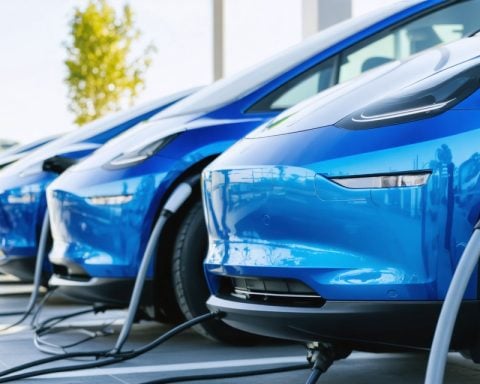- InCharge Energy and DLL have partnered to enhance electric vehicle adoption by addressing financial barriers.
- The collaboration offers flexible financing solutions for developing electric fleet charging infrastructure.
- InCharge Energy provides comprehensive charging solutions, while DLL navigates financing to reduce costs.
- The partnership aims to accelerate the decarbonization process, benefiting the environment and fleet operators economically.
- Adrian Leach of DLL emphasizes making cleaner transportation accessible and affordable as a key goal.
- This initiative could significantly promote the adoption of electric vehicles among businesses, schools, and public agencies.
- The partnership represents a promising step towards making electric fleets the standard rather than the exception.
A bold new collaboration is set to revolutionize the landscape of electric vehicle adoption across the U.S., promising not only more eco-friendly roads but also a more economically feasible pathway for fleets aiming to transition to electric power. InCharge Energy and DLL have joined forces to dismantle the financial hurdles facing organizations eager to embrace cleaner and greener transportation.
Imagine fleets of electric buses navigating city streets or delivery trucks emitting nothing but the gentle hum of electric motors. This vision could soon be a reality as the dynamic duo of InCharge and DLL introduces flexible financing solutions tailored to invigorate electric fleet charging infrastructure.
InCharge Energy, a pioneer in charging solutions, brings its technological prowess to the forefront, offering a rich tapestry of services from hardware to maintenance. Coupled with DLL’s expertise in financial navigation, they present a potent strategy to slice through the prohibitive costs associated with electric vehicle infrastructure.
Adrian Leach from DLL paints a hopeful picture, highlighting the partnership’s commitment to making cleaner transportation solutions accessible and affordable. This fusion of strengths aims to accelerate the shift towards decarbonization, a boon not only for the environment but also for the economic viability of fleet operators.
As the companies illuminate paths toward sustainability, the future gleams with promise. Businesses, schools, and public agencies can more readily imagine a landscape where electric fleets are not just the ideal, but the norm. This innovative financial framework could indeed be the missing piece that propels the widespread adoption of electric vehicles. One thing is certain: the road to a sustainable future has never looked more inviting.
Revolutionizing Electric Vehicle Adoption: What InCharge Energy and DLL’s Collaboration Means for the Future
How-To Steps & Life Hacks: Transitioning Fleets to Electric
1. Evaluate Current Fleet: Analyze the composition and usage patterns of your current fleet. Identify which vehicles could be replaced with electric alternatives.
2. Assess Infrastructure Needs: Determine the charging infrastructure required, focusing on both hardware and software solutions that InCharge Energy can provide.
3. Calculate Costs and Savings: Use DLL’s financial tools to calculate the upfront costs, potential savings, and total cost of ownership over the fleet’s lifespan.
4. Apply for Financing: Explore flexible financing solutions offered through the collaboration, which can ease the initial financial burden of transitioning to electric.
5. Implement and Monitor: Deploy the new electric fleet and monitor performance. Utilize maintenance services for optimal performance and longevity.
Real-World Use Cases
– Municipal Bus Fleets: Cities like Los Angeles and Chicago are transitioning their public transport fleets to electric to reduce urban pollution.
– Delivery Services: Companies such as Amazon have begun integrating electric delivery vehicles, reducing their carbon footprint.
– School Buses: Schools are benefiting from cleaner air and reduced fuel costs by converting buses to electric power.
Market Forecasts & Industry Trends
– Growth Projection: The global electric vehicle market size was valued at USD 162.34 billion in 2019 and is projected to reach USD 802.81 billion by 2027, growing at a CAGR of 22.6% from 2020 to 2027 (Fortune Business Insights).
– Infrastructure Expansion: A significant increase in charging stations is anticipated, supported by government initiatives and private partnerships like that of InCharge and DLL.
Reviews & Comparisons
– InCharge Energy’s Solutions: Known for robust software and adaptable hardware solutions suitable for various fleet needs.
– DLL’s Financing: Offers unique leasing and financial structures catered to different business scales and needs.
Controversies & Limitations
– Initial Costs: While financing options help, high initial costs still pose a barrier without long-term commitment.
– Range Anxiety: Concerns about vehicle battery ranges persist, particularly in remote areas.
Features, Specs & Pricing
– Charging Infrastructure: InCharge provides customizable solutions that include fast chargers suitable for large fleets.
– Financial Options: DLL offers tiered financing plans, allowing businesses to choose options that best fit their budget and growth plans.
Security & Sustainability
– Cybersecurity: InCharge implements rigorous security measures to protect the charging network from cyber threats.
– Environmental Impact: Both companies promote sustainable practices from sourcing to end-of-life disposal of EV components.
Insights & Predictions
– Broad Adoption: Expect increasing acceptance among businesses and municipalities as more use cases prove successful.
– Technological Innovations: Advancements in battery technology and cost reduction will further propel market growth.
Pros & Cons Overview
Pros:
– Reduced environmental footprint
– Long-term cost savings
– Innovative financial solutions
Cons:
– Higher upfront costs
– Dependence on evolving technology
Actionable Recommendations
1. Conduct Compatibility Reviews: Ensure charging solutions and vehicles are compatible—infrastructure assessment is key.
2. Utilize Government Incentives: Leverage available tax incentives and grants to subsidize costs.
3. Explore Scalable Options: Start small and scale up as savings and operational benefits become evident.
Transitioning to electric fleets can be a complex process, but partnerships like that of InCharge Energy and DLL make it increasingly accessible and financially viable. For further exploration of their offerings and how they can support your business, visit InCharge Energy or DLL.














